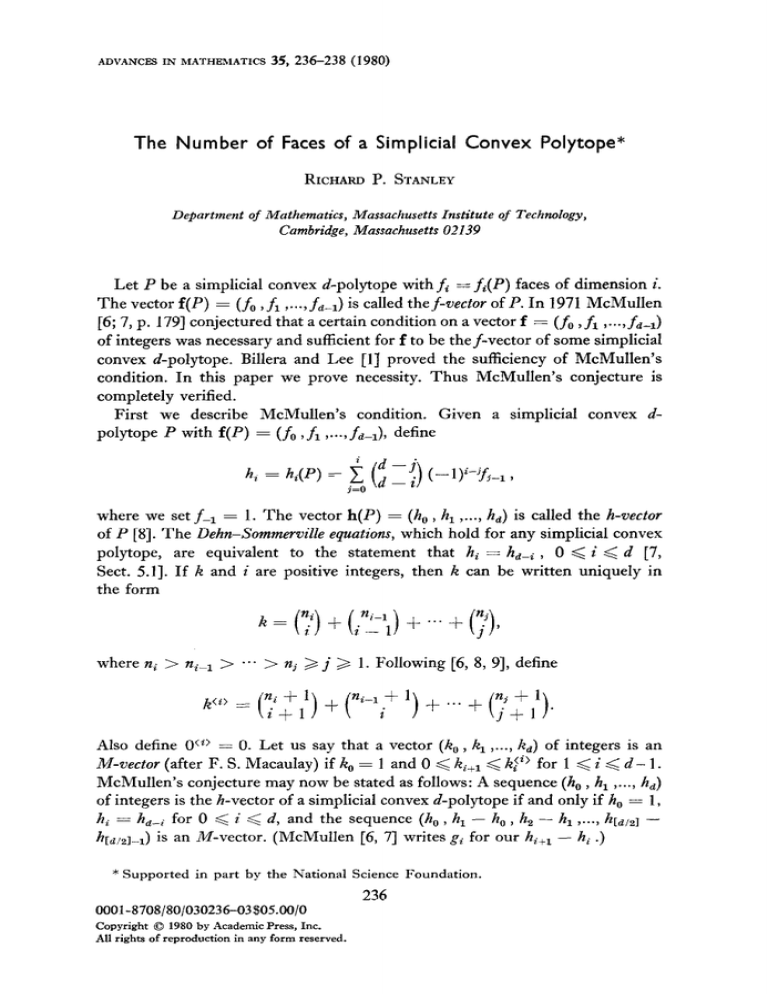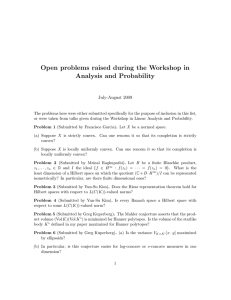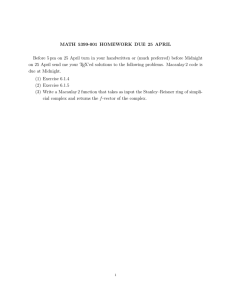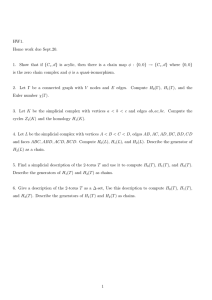The Number Convex Polytope*
advertisement

ADVANCES IN MATHEMATICS The Number 35, 236-238 (1980) of Faces of a Simplicial of Mathematics, Cambridge, Polytope* P. STANLEY RICHARD Department Convex Massachusetts Massachusetts of Technology, Institute 02139 Let P be a simplicial convex d-polytope with fi = fi(P) faces of dimension i. The vector f(P) = (f. , fi ,..., fdel) is called the f-vector of P. In 1971 McMullen [6; 7, p. 1791 conjectured that a certain condition on a vector f = (f. ,fi ,...,fd...J of integers was necessary and sufficient for f to be the f-vector of some simplicial convex d-polytope. Billera and Lee [l] proved the sufficiency of McMullen’s condition. In this paper we prove necessity. Thus McMullen’s conjecture is completely verified. First we describe McMullen’s condition. Given a simplicial convex dpolytope P with f(P) = (f. , fi ,...,f&, define where we set fel = 1. The vector h(P) = (h, , h, ,..., hd) is called the h-vector of P 181. The Dehn-Sommerville equations, which hold for any simplicial convex polytope, are equivalent to the statement that hi = hdpi , 0 < i ,< d [7, Sect. 5.11. If k and i are positive integers, then k can be written uniquely in the form h = (7) + (;“-;) where + ..’ + (q), ni > ni_r > ... > nj > j > 1. Following h’i’ = (y+,‘) + (n6-1; 1) + [6, 8, 91, define .. . + (7;;). Also define Oci> = 0. Let us say that a vector (k, , k, ,..., Kd) of integers is an M-vector (after F. S. Macaulay) if k, = 1 and 0 < k,.+r < kii’ for 1 < i ,( d - 1. McMullen’s conjecture may now be stated as follows: A sequence (h, , h, ,..., hd) of integers is the h-vector of a simplicial convex d-polytope if and only if h, = 1, hzi = h,+. for 0 < i < d, and the sequence (h, , h, - h, , h, - hl ,..., h[d,21 hcd,& is an M-vector. (McMullen [6, 71 writes gi for our h,+l - hi .) * Supported in part by the National Science 236 OOOl-8708/80/030236-03$05.00/0 Copyright AU rights 0 1980 by Academic Press, Inc. of reproduction in any form reserved. Foundation. THE NUMBER OF FACES 231 We now show the necessity of this condition. By a result essentially due to Macaulay [5l (stated more explicitly in [9, Theorem 2.2]), a sequence (k, ,..., Kd) is an AI-vector if and only if there exists a graded commutative algebra R = R, @ R, @ .*. @ R, over a field K = R,, , generated (as an algebra with identity) by Rl , such that the Hilbert function H(R, n) : = dim, R, is given by H(R, n) = k, . Let P be a simplicial convex d-polytope in [Wd. Since P is simplicial, we do not change the combinatorial structure of P (including the f-vector) by making small perturbations of the vertices of P and the taking the convex hull of these new vertices. Hence we may assume that the vertices of P lie in Qd. Without loss of generality we may also assume that the origin is in the interior of P. For every proper face ar of P, define a, to be the union of all rays whose vertex is the origin and which intersect 01.Thus a, is a simplicial cone. The set (a,} of all such cones forms a completesimpliciulfan Z [2, Sect. 51. To such a fan is associated a complete complex variety X, [4; 2, Sect. 5; 13, p. 5581. The cohomology ring A = H*(X, , Q) of this variety satisfies H2i+l(Xz , Q) = 0 [2, Sect. 10.91, and hence is commutative and may be graded by setting Ai = H2i(Xz, Q). With this grading we have that A is generated by A, and that dimo A, = h,(P) [2, Theorem 10.8 and Remark 10.91. Now define a function 4: UP -+ 08 by 4(x) = - 11x II/11x’ 11,where 11. 11denotes the Euclidean norm and where x’ is the intersection of the boundary of P with the ray with vertex at the origin passing through x. Then $ is convex, continuous, linear on each cone a, , and a di@wnt linear function on each maximal cone (TV. Hence by the criterion [4, Chap. II, Sect. 2; 2, Sect. 6.9; 13, p. 5701 for projectivity of Xo, where Q is a complete fan, we conclude that X, is projective. It then follows by a result of Steenbrink [l 1, Theorem 1 .13] that the hard Lefschetz theorem (see, e.g., [3, p. 1221) holds for X,. This means that there is an element w E H2(X, Q) = A, (the class of a hyperplane section) such that for 0 < i < [d/2] the map A i -+ A,_i given by multiplication by wd-2i is a bijection. In particular, by w is injective if 0 < i < [d/2]. the map Ai --f Ai+l given by multiplication Now let I be the ideal of A generated by w and A[d,21+l . It follows that the Hilbert function of the quotient ring R = A/I is given by H(R, i) = hi - hiel , 1 < i < [d/2]. Hence (h, , h, - h, ,..., htdi21 - h~~,~l-r) is an M-vector, and the proof is complete. The above proof relies on two developments from algebraic geometry: the varieties X,first defined in [13] and [4], and the hard Lefschetz theorem. The close connection between the varieties X, and the combinatorics of convex polytopes has been apparent since [4, 131, whil e in fact a direct application of these varieties to combinatorics has been given by Teissier [12]. On the other hand, an application of the hard Lefschetz theorem to combinatorics appears in [lo]. Let A be a triangulation of the sphere sd--L. We can define thef-vector and h-vector of A exactly as for simplicial convex polytopes, and it is natural to ask [6, p. 5691 whether McMullen’s conjecture extends to this situation. It is well known that the Dehn-Sommerville equations hi = hdPi continue to hold for A, 238 RICHARD P. STANLEY and in [8] it was shown that the h-vector (h, , h, ,..., hd) of A is an; M-vector. However, it remains open whether (h, , h, - h, ,..., Iqd/sl - h[d,21--1) is always an M-vector. ACKNOWLEDGMENT I am grateful assistance. to M. Artin, S. Kleiman, and D. Mumford for invaluable technical REFERENCES 1. L. J. BILLERA AND C. W. LEE, Sufficiency of McMullen’s conditions for f-vectors of simplicial polytopes, preprint. 2. V. I. DANILOV, The geometry of toric varieties, Russian Math. Surveys 33, No. 2 (1978), 97-154; translated from Uspekhi Mat. Nauk. 33, No. 2 (1978), 85-134. 3. P. GRIFFITHS AND J. HARRIS, “Principles of Algebraic Geometry,” Wiley, New York, 1978. 4. G. KEMPF, F. KNUDSEN, D. MUMFORD, AND B. SAINT-DONAT, “Toroidal Embeddings I,” Lecture Notes in Mathematics No. 339, Springer-Verlag, Berlin/Heidelberg/ New York, 1973. 5. F. S. MACAWLAY, Some properties of enumeration in the theory of modular systems, Proc. London Math. Sot. 26 (1927), 531-555. 6. P. MCMULLEN, The numbers of faces of simplicial polytopes, Israel J. Math. 9 (1971), 559-570. 7. P. MCMULLEN AND G. C. SHEPHARD, “Convex Polytopes and the Upper Bound Conjecture,” London Math. Sot. Lecture Note Series, Vol. 3, Cambridge Univ. Press, London/New York, 1971. 8. R. STANLEY, The upper bound conjecture and Cohen-Macaulay rings, Studies in Applied Math. 54 (1975), 135-142. 9. R. STANLEY, Hilbert functions of graded algebras, Adwances in Math. 28 (1978), 57-83. 10. R. STANLEY, Weyl groups, the hard Lefschetz theorem, and the Sperner property, SIAM J. Algebraic Discrete Methods, in press. II. J. H. M. STEENBRINK, Mixed Hodge structure on the vanishing cohomology, in “Real and complex singularities, Oslo 1976” (P. Holm, Ed.), pp. 525-563, Sijthoff & Noordhoff, Alphen aan den Rijn, The Netherlands, 1977. 12. B. TEISSIER, Du thbor&me de l’index de Hodge aux inCga1itt.s isop&imCtriques, C. R. Acad. Sci. Paris Ser. A 288 (1979). 287-289. 13. M. DEMAZURE, Sous-groupes algkbriques de rang maximum du groupe de Cremona, Ann. Scient. ri’c. Norm. Sup. 3 (1970), 507-588.




